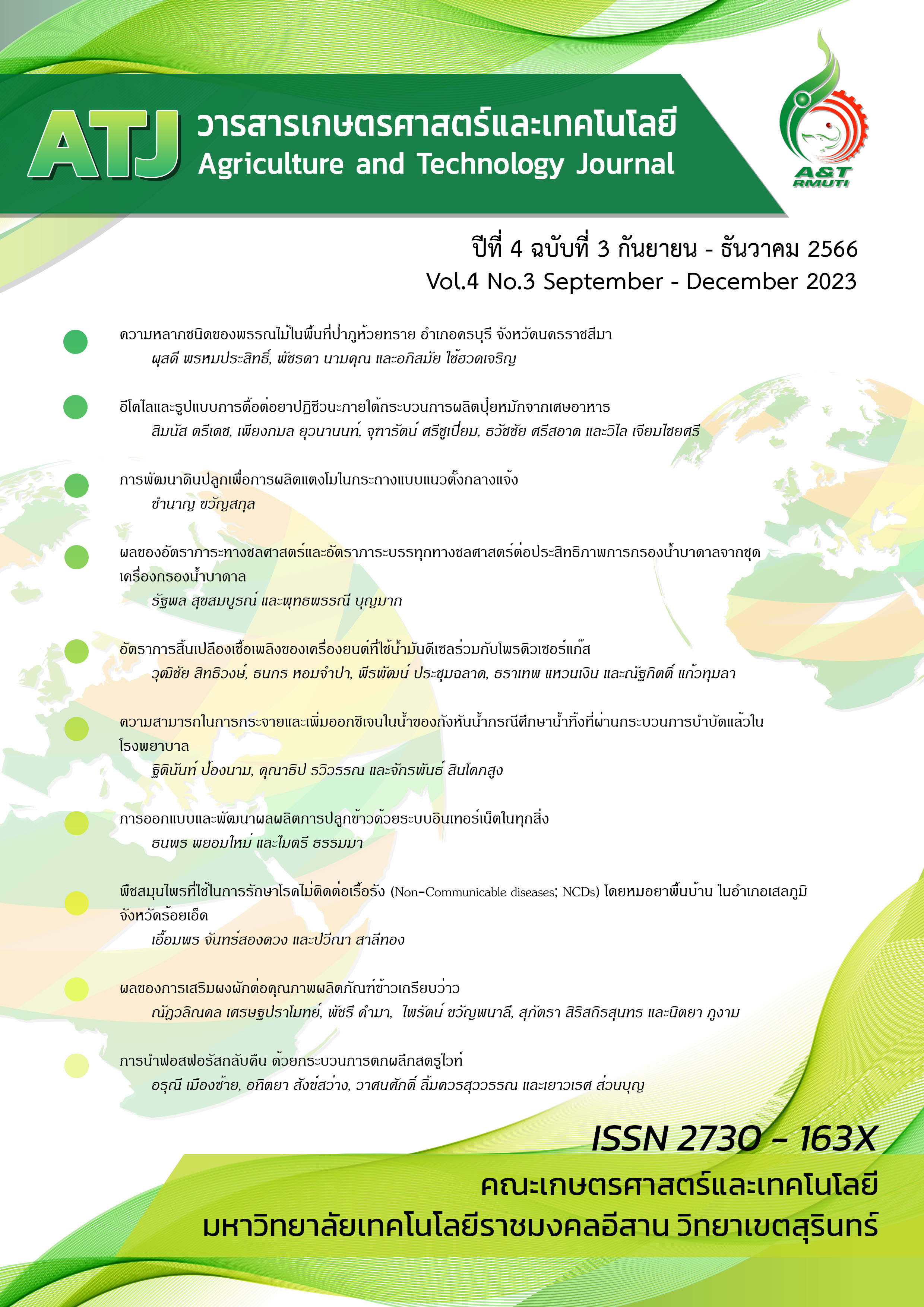Phosphorus recovery using a struvite crystallization process
Keywords:
Agriculture, Ethanol Industry, Phosphorus, StruviteAbstract
Struvite in wastewater of industrial process is part of the cause of blocking in the pipes line of the wastewater treatment system, the cost increases and wastes more time to solve the problem. On the other hand, considering the composition of struvite, it contains phosphorus, which can be used as a fertilizer and valuable in agriculture. Therefore, this research was to study the optimum conditions of the chemical crystallization process of struvite in the wastewater from a cassava ethanol production plant. The properties of wastewater and optimum conditions for the crystallization of struvite, including the pH and the molar ratio of magnesium to phosphorus (Mg:P), were identified. The properties of wastewater showed that the average value of pH was 4.32. While Mg, NH3, and P were 4,192.5, 347.2, and 267.33 milligrams per liter (mg/L), respectively. The filtered and unfiltered wastewater tests found that filtered wastewater sludge contained struvite and was less contaminated with other organic matter. Therefore, it was used to crystallize struvite. The result found that pH at 9.5, 10, and 11 performed quite a lot of crystallization of struvite. However, the optimum pH was at pH 10 since it can reclaim more than 98% phosphorus. Testing the ratio between magnesium and phosphorus (Mg:P) found that at pH 9.5, the proportion of struvite crystallization was also increased. At the proportion 1:1 to 5:1, struvite crystals grew from 124.10 mg/L to 213.80 mg/L. The optimum condition found in this study was the ratio of 5:1 at pH 9.5, which increased the crystallization of struvite, and the phosphorus reversal was more than 97%, helping to bring back phosphorus from wastewater to use in agriculture.
References
ธาดา ฉัตรธานี. (2531). การบำบัดน้ำเสียจากโรงงานแป้งมันสำปะหลังโดยกระบวนการไร้ออกซิเจนอิสระแบบสองขั้นตอน. วิทยานิพนธ์ปริญญาวิศวกรรมศาสตรมหาบัณฑิต สาขาวิชาวิศวกรรมสุขาภิบาล บัณฑิตวิทยาลัย จุฬาลงกรณ์มหาวิทยาลัย.
นิธิวัฒน์ จำรูญรัตน์. (2531). การกำจัดแอมโมเนียและฟอสฟอรัสพร้อมกันโดยกระบวนการตกตะกอนทางเคมี. วิทยานิพนธ์ปริญญาวิศวกรรมศาสตรมหาบัณฑิต สาขาวิศวกรรมสุขาภิบาล บัณฑิตวิทยาลัย จุฬาลงกรณ์มหาวิทยาลัย.
ฝ่ายสุขาภิบาลโรงงาน กองอนามัยสิ่งแวดล้อม สำนักอนามัยกรุงเทพมหานคร. (2560). น้ำเสียและการบำบัดน้ำเสีย. ค้นเมื่อ 18 กรกฎาคม 2563. https://web.ku.ac.th/schoolnet/snet6/envi3/water/solu.htm.
พิชญา วงศ์ผุดผาด. (2559). การศึกษาปัจจัยที่มีผลต่อขนาดของผลึกสตรูไวท์ซึ่งนำกลับจากน้ำเสียฟาร์มสุกรร่วมกับน้ำทะเล. วิทยานิพนธ์ปริญญาวิศวกรรมศาสตรมหาบัณฑิต สาขาวิศวกรรมสิ่งแวดล้อม บัณฑิตวิทยาลัย มหาวิทยาลัยเทคโนโลยีพระจอมเกล้าธนบุรี.
รอบรู้ รังสิเวค. (2560). การผลิตปุ๋ยสตรูไวท์จากน้ำเสียที่ผ่านการบำบัดจากโรงงานเกษตรอุตสาหกรรมและฟาร์มสุกร. รายงานการวิจัย. คณะวิศวกรรมศาสตร์ มหาวิทยาลัยบูรพา. ชลบุรี.
APHA (American Public Health Association), AWWA (American Water Works Association), and WEF (Water Environment Federation). (2005). Standard methods for the examination of water and wastewater. 21th ed. Method.
Desmidt E., Ghyselbrecht K., Monballiu A., Rabaey K., Verstraete W. and Meesschaert B.D. (2013). Factors influencing urease driven struvite precipitation. Separation and Purification Technology. 110. 150-157.
Hallas J., Mackowiak C., Wilkie A. and Harris W. (2019). Struvite phosphorus recovery from aerobically digested municipal wastewater. Sustainability. 376. 1-12.
Kataki S., West H., Clarke M. and Baruah, D.C. (2016). Phosphorus recovery as struvite from farm, municipal and industrial waste: Feedstock suitability, methods and pre-treatments. Waste Management. 49. 437-454.
Li B., Huang H.M., Boiarkina I., Yu W., Huang Y.F., Wang G.Q. and Young B.R. (2019). Phosphorus recovery through struvite crystallization: Recent developments in the understanding of operational factors. Journal of environmental management. 248. 1-10.
Taddeo R., Kolppo K. and Lepistö R. (2016). Sustainable nutrients recovery and recycling by optimizing the chemical addition sequence for struvite precipitation from raw swine slurries. Journal of Environmental Management. 180. 52-58.
Downloads
Published
Versions
- 2024-02-20 (2)
- 2023-12-29 (1)
How to Cite
Issue
Section
License
Copyright (c) 2023 Agriculture and Technology Journal

This work is licensed under a Creative Commons Attribution-NonCommercial-NoDerivatives 4.0 International License.
เนื้อหาและข้อมูลในบทความที่ลงตีพิมพ์ในวารสารทดสอบระบบ ThaiJo2 ถือเป็นข้อคิดเห็นและความรับผิดชอบของผู้เขียนบทความโดยตรงซึ่งกองบรรณาธิการวารสาร ไม่จำเป็นต้องเห็นด้วย หรือร่วมรับผิดชอบใดๆ
บทความ ข้อมูล เนื่อหา รูปภาพ ฯลฯ ที่ได้รับการดีพิมพ์ในวารสารทดสอบระบบ ThaiJo2 ถือเป็นลิขสิทธิ์ของวารสารทดสอบระบบ ThaiJo2 หากบุคคลหรือหน่วยงานใดต้องการนำทั้งหมดหรือส่วนหนึ่งส่วนใดไปเผยแพร่หรือเพื่อกระทำการใดๆ จะต้องได้รับอนุญาตเป็นลายลักอักษรณ์จากวารสารทดสอบระบบ ThaiJo2 ก่อนเท่านั้น






